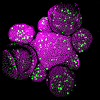
Model of poplar macrofibril assembly without (left) and with callose deposition (right). Callose self-aggregates in between macrofibrils, which explains the observed increase in secondary cell wall porosity. The range of pore size affected is 4–30 nm, which is in the size range of hydrolytic enzymes. As such, callose is believed to act as a hydrophilic spacer of secondary cell wall polymer, further promoting access to hydrolytic enzymes for subsequent saccharification. (Figure originall published in Bourdon et al, 2023 Nature Plants.
Wood modification boosts biomass conversion
By adding a naturally-occurring polymer that makes wood more porous, scientists have engineered trees easier to disassemble into simpler building blocks.
Fossil fuels are the major source of energy, chemicals and many materials but are responsible for a substantial portion of greenhouse gas emissions. To reach carbon neutrality, much of what’s made from fossil fuels today will have to be made from biomass tomorrow. With growing demand for sustainable materials and renewable energy, plant-based feedstocks have been investigated, but converting woody plant biomass to fuel and other useful products is chemically and energetically very demanding.
Until today, research to understand how to change woody biomass to improve its efficiency of conversion to simpler components has mostly targeted the complex polymers already present in wood.
Matthieu Bourdon and colleagues have taken a different approach. They took callose, a polymer that is naturally occurring in some cell walls of plants, and successfully engineered it into the specialised secondary cell walls of plants – the wood. Published in Nature Plants, the research involving international collaborations across multiple institutes shows callose-enriched wood is much more easily converted into simple sugars and bioethanol than non-engineered wood.
Dr Bourdon, former researcher at Sainsbury Laboratory Cambridge University (SLCU) who is now at the Friedrich Miescher Institute for Biomedical Research, first transformed the diminutive model plant, thale cress (Arabidopsis thaliana) to biosynthesise callose in its secondary walls. “We showed that the plants could accommodate a new polymer in their secondary cell walls without any negative impact on growth.” he said.
Engineering trees to be a more efficient & sustainable feedstock for biomass conversion
Switching to a fast-growing tree, the deciduous Hybrid Aspen Poplar (Populus tremula x tremuloides), the team found callose-enriched wood showed interesting new properties, like an increased hygroscopicity and porosity, which makes the polymers more accessible for extracting and converting into simpler building blocks like sugars or bioethanol.
“Understanding the ultrastructural effects of callose addition on the engineered wood was very challenging. The cutting-edge experiments performed by Paul Dupree’s and Ray Dupree’s teams in Cambridge and Warwick University are a cornerstone of this story. In fact, they surprisingly revealed that callose did not interact with other polymers but suggested that callose could act as a cell wall spacer attracting water. This approach inspired us to search for answers beyond our own expertise and establish further collaborations to produce this multi-disciplinary piece of research, ranging from genetic engineering, biochemistry and structural biology to material science.” Dr Bourdon said.
“We foresee that our engineered wood will benefit biomaterials and biofuels production relying on biomass deconstruction and polymer accessibility, such as packaging materials or even advanced biomaterials like cellulose nanofibrils and delignified wood. The next step is to carry out field trials to confirm our findings and to assess the performance of the callose-enriched trees under real forestry conditions. We also hope that our finding introducing a new polymer into wood will inspire other researchers to introduce other types of polymers for tailored applications.”
Reference
Matthieu Bourdon, Jan J. Lyczakowski, Rosalie Cresswell, Sam Amsbury, Francisco Vilaplana, Marie-Joo Le Guen, Nadège Follain, Raymond Wightman, Chang Su, Fulgencio Alatorre-Cobos, Maximilian Ritter, Aleksandra Liszka, Oliver M. Terrett, Shri Ram Yadav, Anne Vatén, Kaisa Nieminen, Gugan Eswaran, Juan Alonso-Serra, Karin H. Müller, Dinu Iuga, Pal Csaba Miskolczi, Lothar Kalmbach, Sofia Otero, Ari Pekka Mähönen, Rishikesh Bhalerao, Vincent Bulone, Shawn D. Mansfield, Stefan Hill, Ingo Burgert, Johnny Beaugrand, Yoselin Benitez-Alfonso, Ray Dupree, Paul Dupree & Ykä Helariutta (2023) Ectopic callose deposition into woody biomass modulates the nano-architecture of macrofibrils. Nature Plants.





